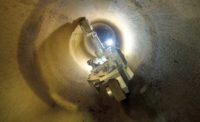'Street-View' Cars Map Gas Leaks In Service For Utilities

















































Rapid and accurate detection of methane leaks is being offered to natural-gas utility companies following a successful pilot project led by the Environmental Defense Fund, in partnership with Google Earth Outreach.
The program uses Google Street View cars driving 20 mph and outfitted with technology that tests air samples twice per second. Sensors precisely measure methane concentrations down to 0.02 parts per million. EDF has published online interactive maps of test results from three cities. Website visitors are invited to nominate utilities to be offered the service.
Methane is the principal component of natural gas, so a methane leak indicates an explosion hazard. But methane also is a greenhouse gas that contributes 120 times more to atmospheric heat retention, pound for pound, than carbon dioxide. According to EDF, methane accounts for 25% of the climate change caused by human activities, and locating and repairing methane leaks in utility systems could play an important part in reducing greenhouse-gas emissions.
The Google Street View vehicles used a Piccaro methane analyzer together with a GPS unit to link methane measurements with locations. In each city, drivers drove every public street in the study areas at least two times to ensure accuracy, averaging 80 to 100 miles per day, says Steven Hamburg, EDF's chief scientist.
Two utility companies participated: Citizens Energy Group in Indianapolis and National Grid in Boston and in the New York City borough of Staten Island.
The National Grid systems, like many old utilities in the Northeast, are largely composed of cast iron or other corrosion- or leak-prone materials. In those systems, the survey found an average of one leak per mile, says Hamburg. In Indianapolis, where the system's pipes are plastic and cathodically protected steel, the average was one leak per 200 miles.
"The study didn't find any big leaks we weren't aware of," says Jake Navarro, National Grid spokesman. "We're looking at the data to see what it can tell us."
EDF also is planning a similar mapping project with Southern California Gas Co. A company spokeswoman says there are many sources of methane and other hydrocarbons in its service region.
















